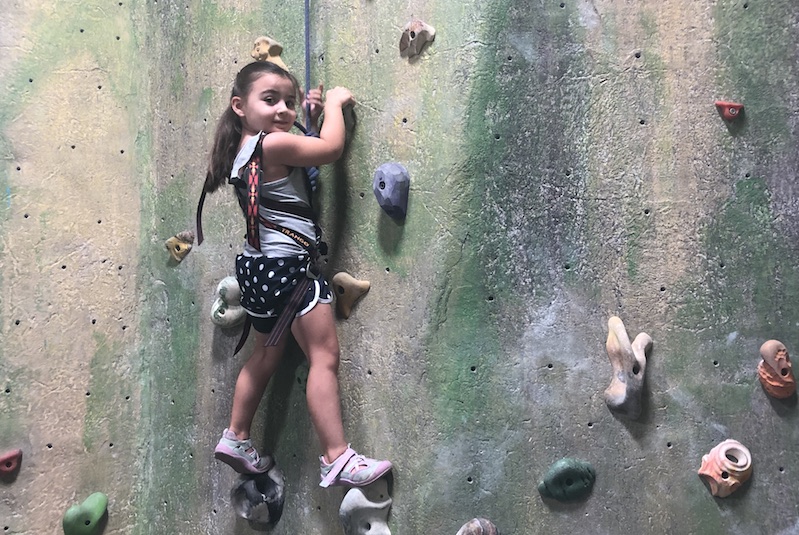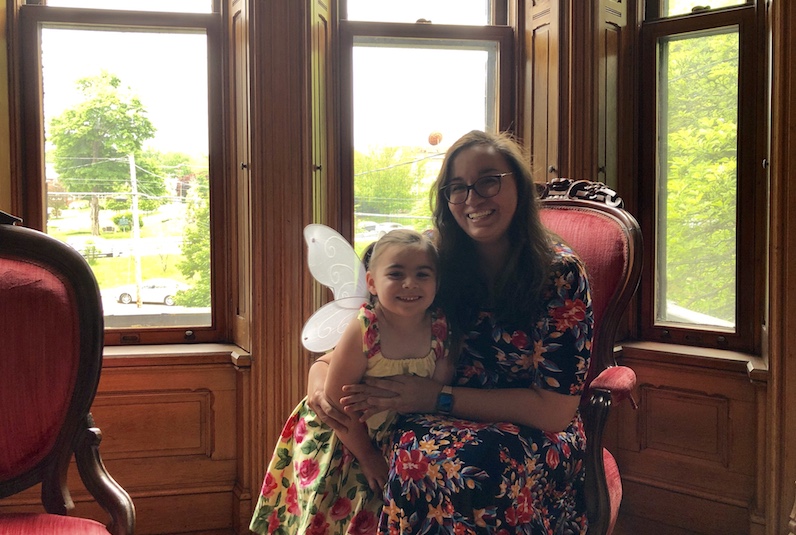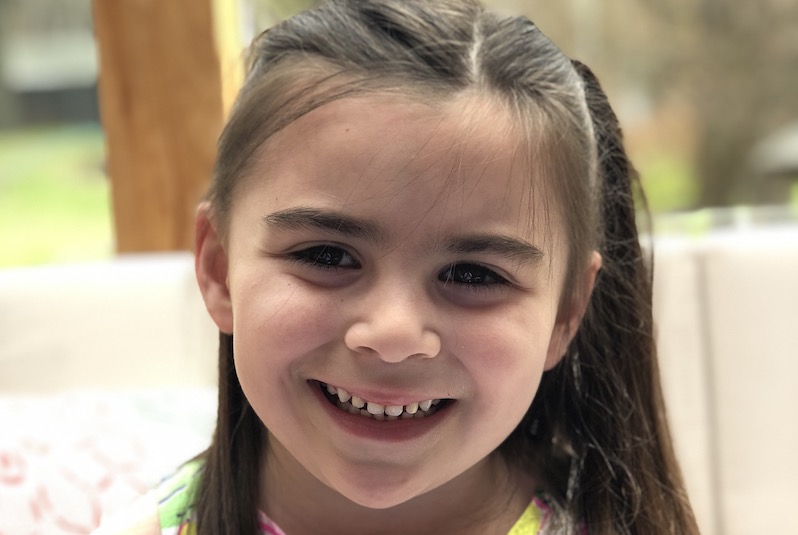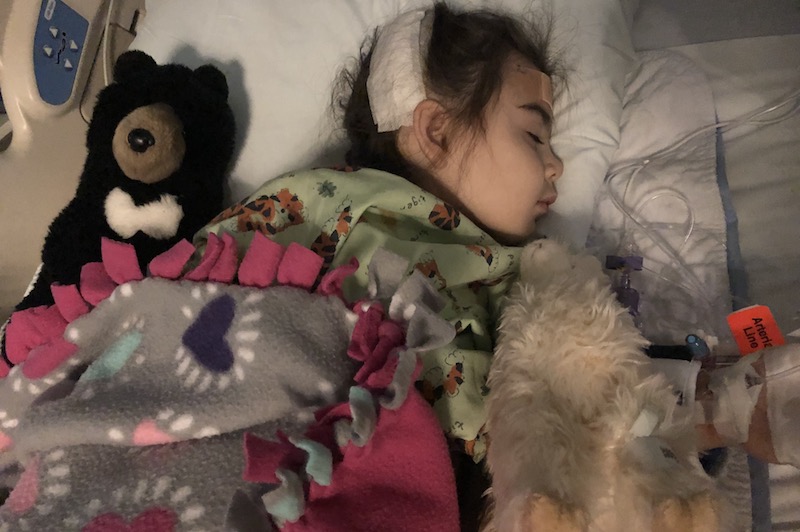Grace: Developing her inner ninja after brain surgery

The McGuigans were enjoying a family dinner at a favorite restaurant last October when their lives took an unexpected turn. In the middle of their meal, 4-year-old Grace suddenly developed a strange look on her face and started rhythmically moving her wrist. When she didn’t respond to her name, her parents, Christina and Nathan, knew something was wrong.
“We tried asking her questions, but she didn’t answer,” says Christina. “Nothing like that had ever happened before, but we thought she might be having a seizure so we called an ambulance.”
A mass in her brain, a transfer to Boston
The ambulance rushed Grace to their local hospital in New Hampshire. Although her seizure had stopped by the time they arrived, the doctors did a quick scan and saw a mass in her brain.
“They said there was little they could do for her, and they were sending us to Boston Children’s Hospital,” says Christina. Because it was too windy for them to be airlifted, the family made the trip to Boston by ambulance instead. It was a frightening few hours.
“The doctors in New Hampshire gave us so little information that we left there thinking the worst,” says Christina. “We just assumed a mass in her brain meant she had cancer.”

When they finally arrived at Boston Children’s late that evening, they met with teams from neurology and neurosurgery who examined Grace and ran several tests. The doctors explained that the mass was most likely a cavernous malformation, a tangle of abnormal blood vessels in the brain, which can cause seizures in the setting of hemorrhage.
“My dad had called and told me he had once had a cavernous malformation, too, so I let the doctors know,” says Christina. “By the next day, they were pretty sure that’s what it was, and an MRI confirmed it was in the area where she had the seizure.”
Creating a treatment plan
The family met with neurosurgeon Dr. Katie Fehnel who recommended surgery to remove the mass. “We were terrified,” says Christina. “Dr. Fehnel said the surgery would stop Grace’s seizures, but it was in an area where it could affect her sensation and visual processing.”
Though the doctors were fairly certain the mass was a cavernous malformation, it was impossible to know for sure until it was removed. It was a lot for the couple to take in. “Two days earlier our daughter had been fine,” says Christina. “And now we were talking about brain surgery. Grace had such long, beautiful hair, I didn’t want her to lose it — for some reason I couldn’t let go of that thought.”

Dr. Fehnel told them that the findings were most consistent with a cavernous malformation, but that the blood could obscure more complex conditions such as an occult aneurysm or arteriovenous malformation, which would alter surgical treatment approaches.
“I currently have a research grant to study cavernous malformations from the Be Brave for Life Foundation and am interested in proteins important for vascular development that may be dysregulated in cavernous malformations.” says Dr. Fehnel. “By better understanding this disease we hope to provide more effective treatments and follow-up care for our patients like Grace.”
Given that Grace had recovered with no further seizures, Dr. Fehnel recommended that they continue her on anti-seizure medications and get a repeat MRI in a few weeks. This would give time for the blood to disappear and to allow for a clearer picture for surgical planning.

Two weeks later, the family returned to Boston for a follow-up MRI. “The image showed the mass was a bit bigger and had bled again, which was concerning to Dr. Fehnel,” says Christina. Unfortunately, the blood still made it difficult to see the underlying lesion. Fortunately, Grace was doing well without seizures, headaches, or any other symptoms. Dr. Fehnel thought it was best to hold off a bit longer to give the blood more time to resolve. She explained that they would try to get a clearer MRI to plan for the safest surgery possible.
Scheduling surgery
One Sunday evening about two weeks later, Grace developed a severe headache. “We called and they told us to come right in,” says Christina. Another MRI revealed the mass had bled again. At this point, Dr. Fehnel was concerned that the recurrent bleeding was putting pressure on Grace’s brain and felt that we would not be able to wait for the blood to resolve on its own. She recommended surgery.

“Dr. Fehnel came to the hospital to talk with us the night before surgery, assuring us it was the best course of action and made us feel really comfortable,” says Christina. “She also told me they wouldn’t have to cut all of Grace’s hair, which made me really happy.”
Grace went into the operating room at about 4 p.m. the next afternoon while her parents waited, nervous but confident, in a nearby waiting room. “The staff was great about keeping us informed about the surgery and Dr. Fehnel came out as soon as it was done to let us know everything went really well,” says Christina. “They even saved the section of Grace’s hair they had to cut and gave it to me.”
The following week, Grace was discharged from the hospital and able to go home. “By the time we left, she was moving fine and could walk down the stairs and jump,” says Christina.
Gymnastics, soccer, and ninja training
After a few months of restricted activity, Grace is making up for lost time. She started gymnastics and soccer this past February and is loving a ninja obstacle class. She also likes drawing, coloring, dancing, and just being silly. Now 5, she’ll be heading off to kindergarten in the fall.

At a recent follow-up MRI, Dr. Fehnel reassured Christina and Nathan that everything looked good and she didn’t expect the cavernous malformation to grow back. Grace will be back for another MRI next year to see where things are at.
“It was a stressful year, with so many unknowns,” says Christina. “But everyone at Boston Children’s was so great and I was always confident she was getting the best care and treatment available.”
Learn more about the Department of Neurosurgery.
Related Posts :
-

Care for a prince: One family’s inspiring journey for encephalocele repair
To hear Peter and Eunice of Kenya tell the story of their son, Prince, is to hear about the power ...
-

Broken signals: Things you may not know about nerve injury
When Dr. Andrea Bauer talks about nerve injuries, she talks about phone cords. A damaged phone cord transmits staticky or ...
-

From pain to purpose: An update on Dylan’s traumatic brain injury
We first introduced you to Dylan four years ago, when a traumatic brain injury led him to the Department of ...
-

This two-handed robot goes deep into the brain
Robots have become common partners in the OR, enabling surgeons to operate through small incisions and manipulate tools endoscopically, avoiding ...





